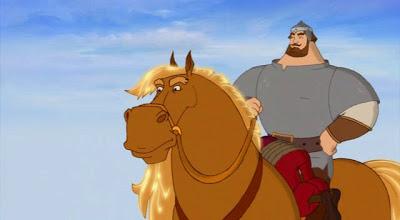by Paul J. Pelkonen

The Russian hero Ilya Muromets and his horse Burushka, as depicted in Vladimit Toropchin's
Ilya Muromets and Nightingale the Robber © 2007 Melnitsa Animation Studio
Started in 1935 as a Works Progress Administration project designed to keep local musicians employed, the BPO enjoys a fierce following. That was demonstrated by the 1,500 supporters who arrived at Carnegie Hall on Wednesday night to wave kelly-green handkerchiefs and support their orchestra under the baton of music director JoAnn Faletta. Giving standing ovations and applauding between movements, the Buffalo supporters were nearly as loud as the massive orchestra on the stage.
Ms. Faletta assembled one of the more interesting programs in this year's festival lineup, presenting two vastly different works whose only common thread is their origin in the former U.S.S.R. The first half of the concert offered Morning Prayers from Life Without Christmas, a poem for strings, alto flute and pre-recorded tape by Georgian composer Giya Kancheli. It premiered in 1991.
This was a gentle, atmospheric piece, evoking the crisis of Christians in Soviet Russia banned from observing Christmas under that oppressive regime. Ms. Faletta drew hushed, atmospheric playing from the large string section. The taped prayers of a boy treble acted as eerie grace notes, along with the solo alto flute that seemed to respond to the softly sung words. The thunderous response from the audience was in direct contrast to the subtlety of this music.
The second half of the program features the Symphony No. 3 (Ilya Muromets") by Reinhold Glière. This is a programmatic symphony from 1912, a set of four vast tone paintings depicting the sweeping landscapes of Kievan Russia and the heroic deeds of Ilya Muromets, the great warrior hero who is beatified as a saint of the Russian Orthodox Church. Due to the Brucknerian length of this symphony and its enormous orchestral requirements, this work is rarely heard outside Russia.
Glière's symphony is organized into four large-scale movements, with each movement retelling an incident in Muromets' life. The first half chronicles the hero's battles against the bandit Solovey ("Nightingale") in a gorgeous slow crescendo, with tinkling percussion indicating the stolen loot adorning the bandit's daughters. A dance movement indicates general celebration, and the climax, which presages the great pictorial symphonic movemens of Shostakovich, recounts Muromets' final heroic charge against invading Tartars, and his death by petrification.
The Buffalo players met the challenge of this music with enthusiasm. Glière calls for enormous orchestra forces, with a full frontal assault of horns and trombones declaring Muromets' heroism. A contrasting theme for high woodwinds depicts the piercing whistle of the Nightingale. there is extensive writing for the contrabassoon, the lowest-pitched member of the orchestra. The music is expansive and hearty, with liberal nods to the scores of Richard Wagner. Sometimes it sounds as if this Russian hero owes a huge debt to the exploits of that composer's Siegfried.

